Sometimes, there’s nothing scarier than a blank page waiting to be filled - especially when it comes to figuring out how to start a resume.
For every position that you apply for, you will need to stand out in a pile of applications through your professional experience, achievements, and education, to impress recruiters.
Just thinking about all this may make starting your resume seem like a Herculean task.
This is exactly why we’ve compiled this article.
- #1. Create Your Resume Outline
- #2. Fix Up The Formatting
- #3. Pick The Right Resume Format
- #4. Start Your Resume Contents With a Contact Information Section
- #5. Pick Between Resume Objective or Summary
- #6. List Your Past Work Experience
- #7. Move On To The Education Section
- #8. Spice Up Your Resume With Your Skills
- #9. Add These Optional Sections
- #10. Start Applying
Step #1. Create Your Resume Outline
So, how to start a resume?
Deciding what to include and what to leave out when you start to write a resume can be tough, whether you’re a professional or a beginner.
As a professional, you might struggle to choose among achievements and skills to include in your resume. Whereas as a beginner you might have issues filling up the gaps due to lack of work experience.
Either way, figuring out what exactly to include when you start your resume isn’t easy.
That’s why we recommend starting your resume by creating a job-winning resume outline. A resume outline will help you by providing a clearly defined structure you can follow when you start to write your resume.
The resume outline makes the process a lot easier by helping you decide on:
- What resume format to use
- Which resume sections to include
- What information to select
Each of these elements will help you start your resume exactly according to your profile. For example, a professional with years of work experience would go for the reverse-chronological format, while a recent college graduate could opt for the skills-based resume format.
Once you have decided on the format, knowing which sections to use and what information to select becomes considerably easier.
Once you have decided on the format, knowing which sections to use and what information to select becomes considerably easier.
A typical resume’s sections include:
- A contact information section
- A resume summary or objective
- Work, and relevant experience
- Education
- Skill and certifications
- And additional sections - if you have space.
We will be going through all the main resume formats, sections, and other relevant information in detail below but first, rejoice - your resume skeleton is ready and you can now start writing your resume!
Step #2. Fix Up The Formatting
Before we jump into the technicalities, let’s talk style and appearance!
Yes, it’s what’s on the inside that counts, but when it comes to resumes, sloppy-looking formatting can put you into a make-it-or-break-it kind of situation. The recruiter won’t be too at fault to think you won’t be suitable for the job if you haven’t taken the effort to adjust the margins or choose the best font for your resume.
Not gonna lie - using a basic text editor to format your resume can be a hassle. One minor slip-up can make all the hours of hard work you invested in perfectly formatting your resume disappear in the blink of an eye.
Well, there’s a solution for that too - using resume builders, such as Novorésumé. An online resume builder will completely take care of formatting your resume, thus making the process of starting a resume crazy fast.
Step #3: Pick The Right Resume Format
There are three types of resume formats to choose from, and your choice will heavily depend on your level of experience and the type of industry you are applying for.
That’s exactly why this step is particularly important when you start writing the resume.
The three resume formats are:
- Reverse Chronological resume format; this is the most popular format among recruiters and the best fit for those who have a great deal of work experience - especially when it fits the job description you are applying for.
- Functional/skill-based resume format; you should start writing your resume following this format if you are a student or recent graduate lacking any work experience, or if you are going through a career change and your previous working experiences are not relevant to the position.
- Combination resume format; Do you have diverse skills or are you applying for a job that requires multi-expertise? The combination resume format is your chance to show that! A position as a Communications Expert, for example, might require you to be skilled in writing, social media, and public relations.
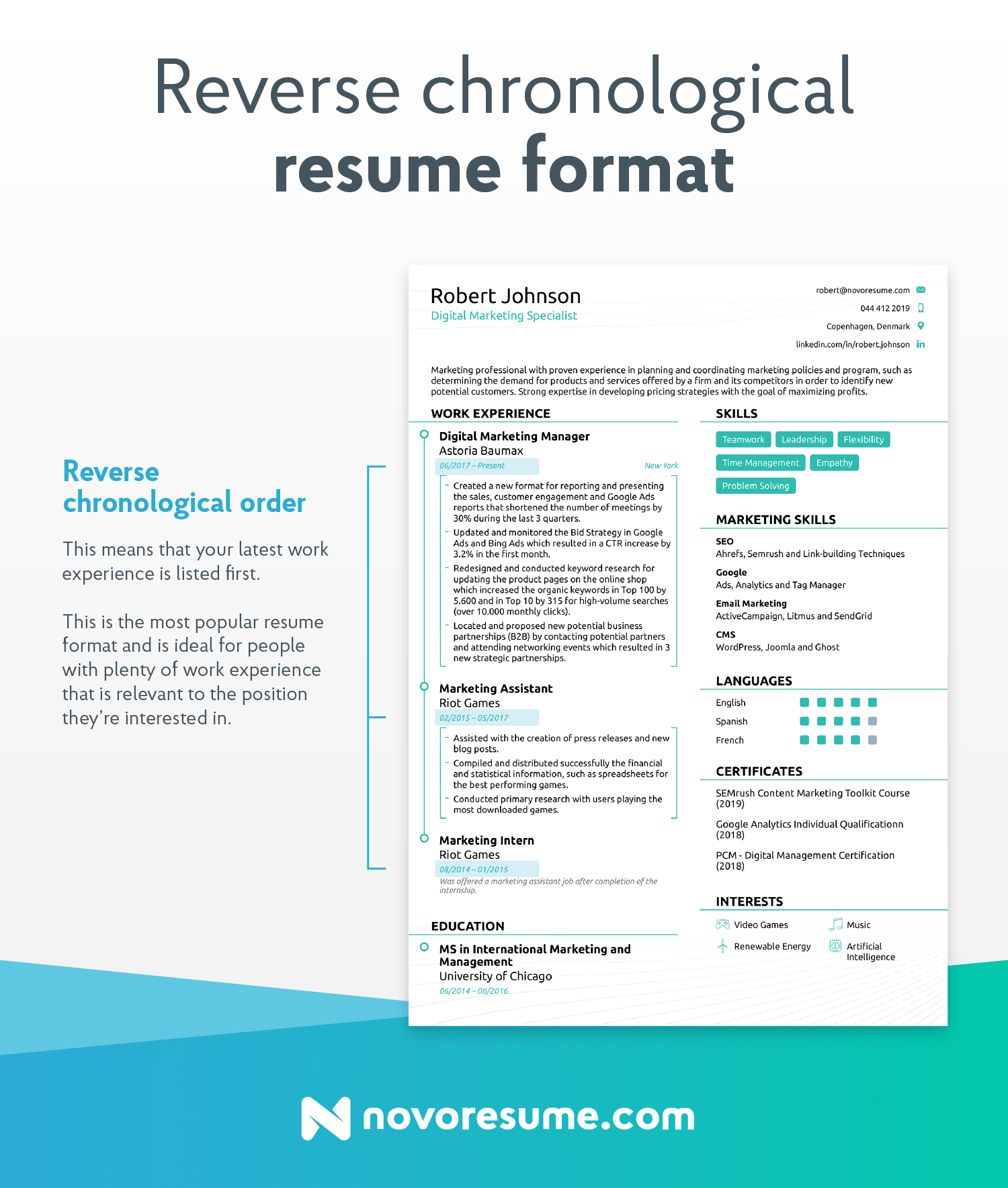
Out of the three, we suggest you choose the reverse-chronological resume format as the most common one among recruiters and HR managers. Nonetheless, what format you choose will eventually come down to your profile and experience.
Due to its popularity, this article focuses on the reverse-chronological resume format. If you wish to go more in-depth into all three resume formats, follow the link!
Step #4. Start Your Resume Contents With a Contact Information Section
This section may sound like a no-brainer, but you must get it right. Imagine being one of the HR manager’s top choices and missing out on your chance due to a spelling mistake in your email.
For this reason, you must double-check that all the contact information you provide is correct and up-to-date.
Now, the contact information section contains mandatory elements and optional ones. Here’s a snapshot:
- First name/Last name
- Phone Number
- Email Address
- Location
- Professional Title (it can be either your current or desired professional title/position)
- Date of birth (unless it is specifically required)
- Unprofessional email address (you know what we mean...any nicknames, wordplay, or variants that don’t include your first and last name are considered unprofessional and will cost you points in the eyes of the recruiter)
- Headshot (in USA, UK & Ireland)
Optional elements:
- LinkedIn Link/ Social Media (if these are up-to-date and add value to your application, there is no harm in including them in your contact information)

Step #5. Pick Between Resume Objective or Summary
It’s science-backed: your CV has about 7 seconds to get a recruiter’s attention. This means that you better make a good first impression, and you better make it fast.
This is where the resume summary, or objective, comes in handy. Placed at the top of your resume, close to the contact information section, a well-crafted resume objective/summary can work miracles in grabbing the HR agent’s attention for more than 7 seconds.
The picture below is a good example:
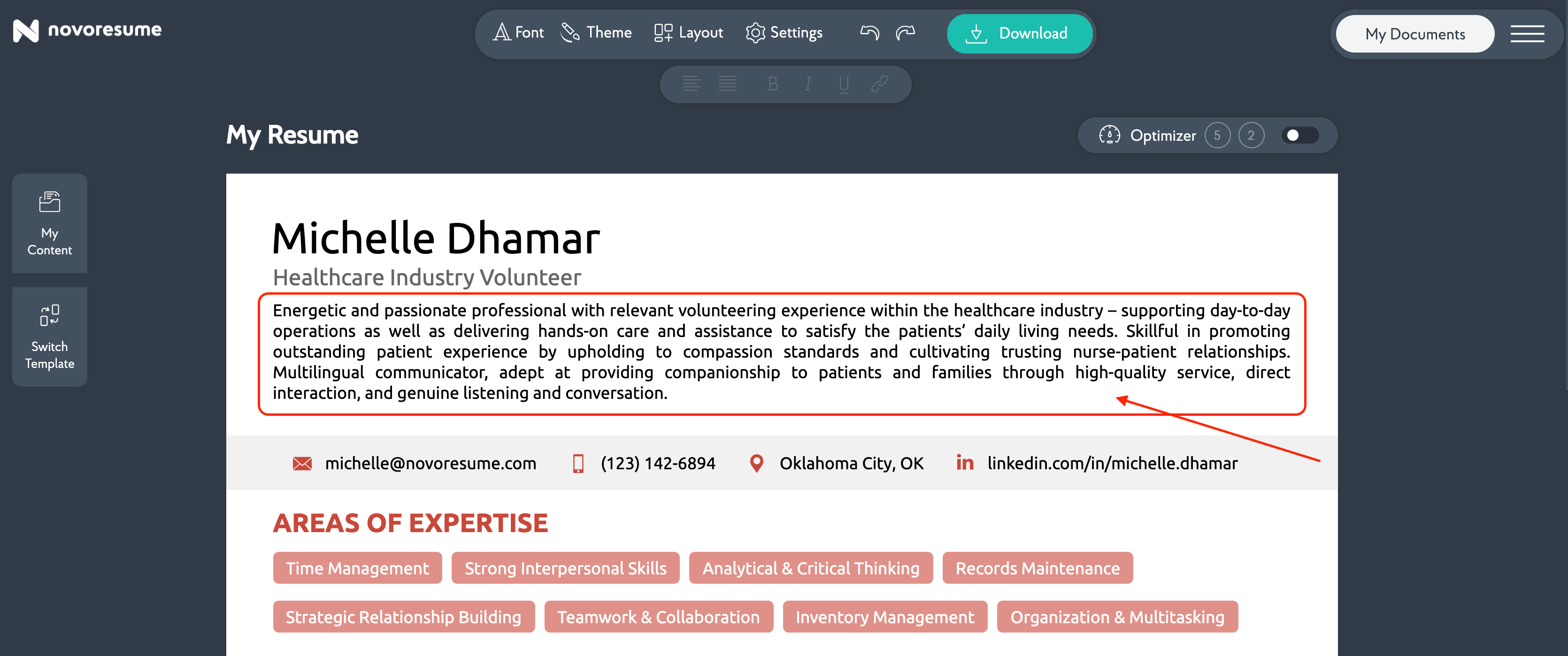
But where does a resume summary differ from an objective, and when to use each?
A resume summary is a short (2-3 sentences) overview of your career so far. The summary is used in 90% of resumes, except for students, recent graduates, or those switching careers. Here’s what you would need to mention:
- Job and years of experience.
- One or two achievements.
- Goal or passion for choosing this specific position.
And here’s an example of what this would look like on your resume:
- Sports journalist with +10 years of experience in covering international tournaments. Successfully covered the 2004 Athens Olympics and the UEFA Euro 2016. Looking to expand my knowledge as a sports correspondent by reporting on a wider range of athletic activities.
A resume objective, on the other hand, represents the goal of your resume. Through the objective, you can explain what motivates you to get into the field, as well as what you can offer. As mentioned above, the resume objective is perfect for those with little work experience or those who are changing careers. To compile it, we suggest using the following formula when you start writing your resume:
- Skill, education, or certification that is relevant to the position.
- Years/months of relevant experience for the position at the company.
- Types of responsibilities you will be able to help with.
Here’s a concrete example for a recent graduate’s resume:
- Motivated graduate with a B.A. in Political Science and International Relations from the University of Greenwich seeking an opportunity to engage in academic political research. 1-year internship at the UK Ministry of Foreign Affairs’ Public Diplomacy Department. Looking to expand my knowledge of international relations and practically assist with research, at the Centre for Defense and International Security Studies think-tank.
Step #6. List Your Past Work Experience
Listing your work experience is practically the most important part of a resume and mastering this section means you will be able to ‘sell’ yourself - your experiences, responsibilities, and achievements - in the most HR-friendly manner.
Not sure how to do that? Several practices will help your resume stand out, but first, let’s go over the basics of the work experience section.
The typical work experience section format goes like this:
- Job Title/Position - it serves the purpose of showing the recruiter evaluating your resume that you have previous experience.
- Company/Location/Description - give information about your previous/current employer, the place where you worked, and potentially a brief description of the company (if it is not well-known).
- Achievements and Responsibilities - this is your chance to shine by showcasing your strengths and skills. As a rule of thumb, it is better to list achievements over responsibilities.
- Dates Employed - this is the time you spent working for each company. The Applicant Tracking System recognizes the mm/yyyy format, so we advise that you follow it.
And here’s how that would look like in your resume:
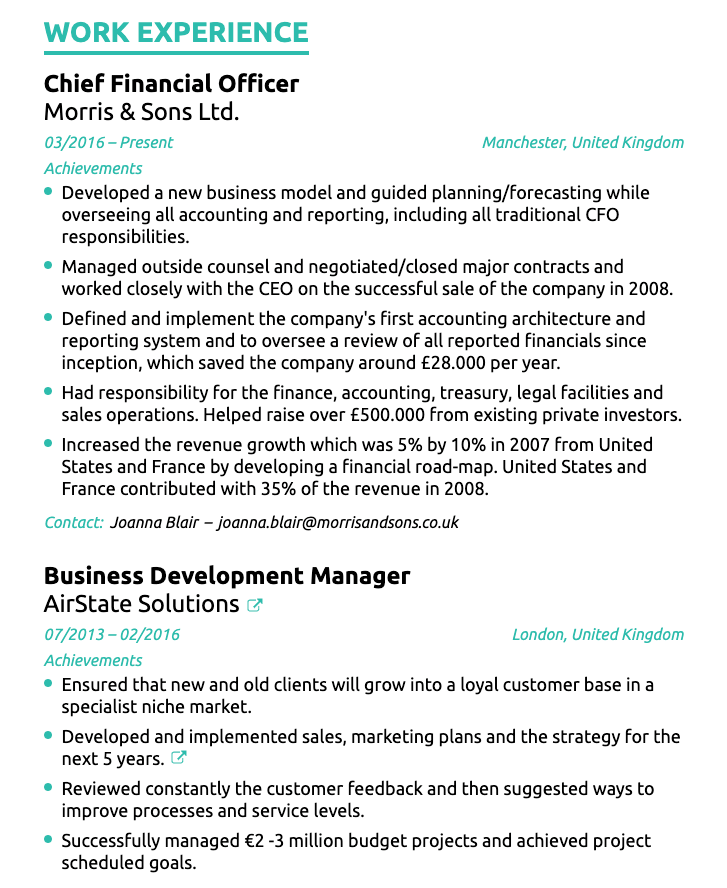
And remember: work experiences should always be listed in reverse-chronological order; start with the most recent one and go all the way back to the past - well, depending on your level of experience.
Now that you know the basics, here are some tips on how to take your work experience to the next level in the eyes of the HR manager.
List Achievements Over Responsibilities
Focus on showing the recruiter your achievements over your responsibilities, whenever you can. Here’s what that means.
HR managers will probably have a general idea of the responsibilities you had in your past positions. If you were a sales manager, for example, some of your responsibilities probably were:
- Reach out to potential clients and maintain relations with existing ones
- Track and report on leads on Customer Relationship Manager.
Thing is, you don’t want your work experience section to look like any other ex-sale manager’s resume, but the fact is the majority of work responsibilities are similar, if not the same.
So, instead, what you do to impress is list your achievements, which in this case would be to show how you helped the company grow, among others.
- Generated $25,000 in sales for the company during my first month.
- Exceeded company sales KPIs by 40% for six consecutive months.
- Reached out to potential clients by email
- Tracked leads on CRM
Of course, some jobs don’t provide many ways to distinguish yourself, and so there might not be that many achievements for you to mention. If, say, you worked in a supermarket, your day to day responsibilities probably involved:
- Categorizing and packing products into shelves
- Helping customers find products
- Attaching price tags and description tags
In cases like this, sticking to your responsibilities is fine.
Tailor Your Resume to the Job
So, there’s another thing standing between you and the recruiter - the Applicant Tracking System. The ATS helps companies scan through all the resumes they receive daily. So this is another thing to consider getting out of the way right as you start writing your resume.
If you’re now thinking there’s no point in perfecting your resume if a software is going to evaluate it, we do have some good news: there are ways to pass the ATS if you tailor your work experience section to the job requirements.
Let’s cover an example from a job ad as an Operations Assistant at the UN Women Organization, with the following requirements:
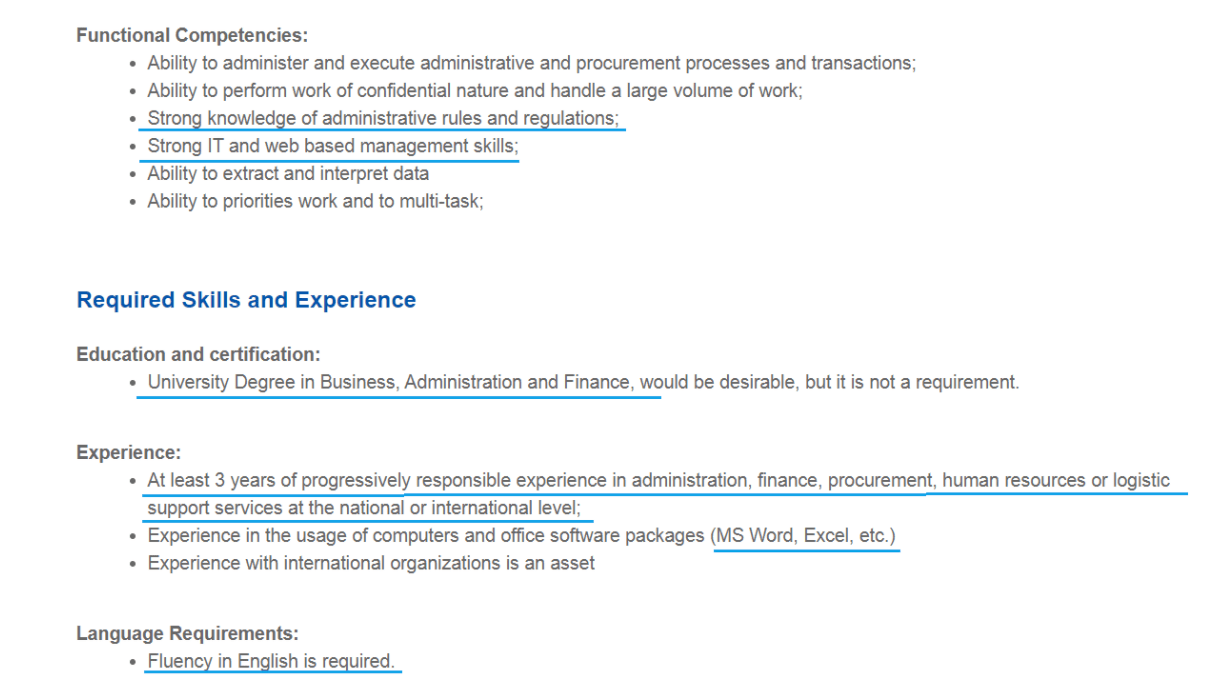
- At least 3 years of experience in administration, finance, procurement, etc.
- Experience in (MS Word, Excel, etc.)
- Fluency in English
- Strong IT and web management skills
If you have the required skills and experience, mention them in your resume and consider your resume tailored for the job.
How Much Work Experience is Necessary?
We mentioned this before - knowing what information to keep and what to leave out might be tricky. And considering the work experience section is the most important, getting this right matters.
Well, the amount of information you mention will go hand in hand with your level of experience. So:
Entry-level candidates should list all the work experiences up to the point of application.
Mid-level professionals should only list work experience relevant to the position.
Senior professionals should list a MAXIMUM of 15 years of relevant work experience.
Step #7. Move On to the Education Section
Your resume's education section comes second per its importance.
As with the other steps, let’s go over the basics of formatting and then some tips on how to make the best out of your academic skills.
- Program Name: E.g. “B.A. in Computer Science”
- University Name: E.g. “University of Colorado”
- Period Attended: E.g. “08/1212 - 05/2016”
- (Optional) GPA: E.g. “3.8 GPA”
- (Optional) Honors: E.g. “Cum Laude, Magna Cum Laude, Summa Cum Laude
- (Optional) Academic Achievements: E.g. Any publications you may have, or courses you have excelled in.
- (Optional) Minor: E.g. “Minor in Information Systems”
Here is an example:
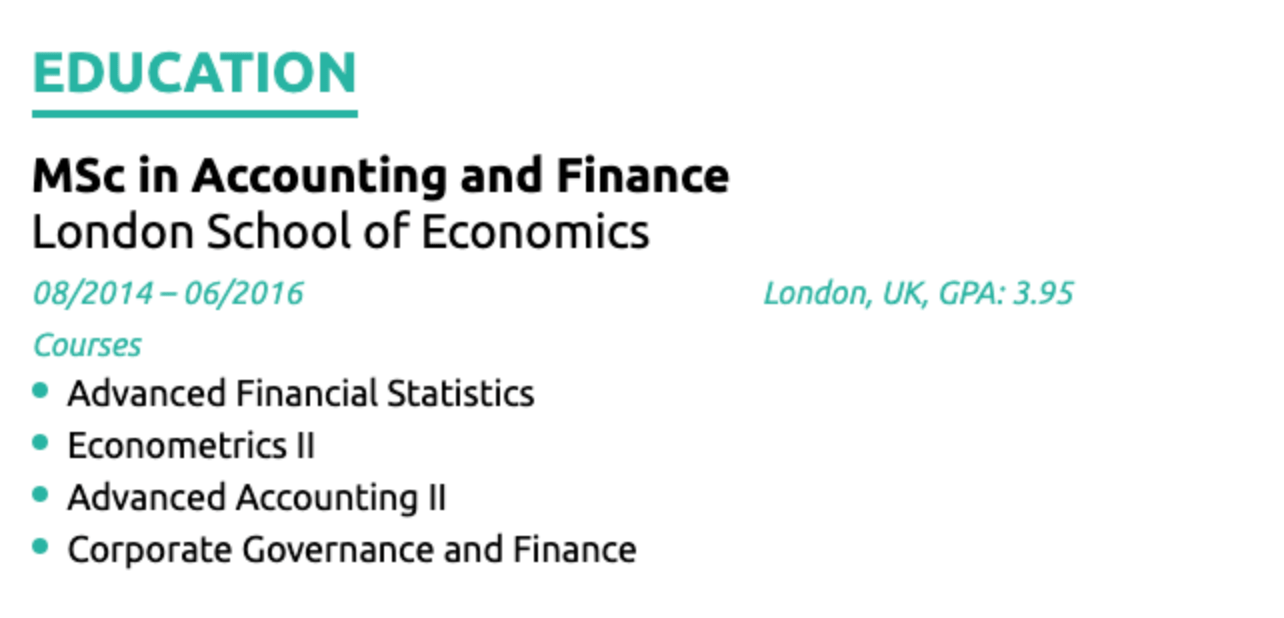
Step #8. Spice Up Your Resume With Your Skills
The ‘skills’ section is your chance to spice things up by showing the HR manager any additional advantage you may have that makes you perfect for the job.
There are two types of skills you can list on your resume:
Hard skills, or measurable abilities. These can range from coding in C++ to being an excellent Italian cuisine chef.
Soft skills, or personal skills. These can be personality traits and social traits, career attributes, or communication skills.
How to List Skills in Your Resume
These are the top three steps to follow when listing skills in your resume:
Step #1: Hard skills are measured with experience levels, meaning you want to mention your proficiency level for every hard skill you list. They are usually categorized into Beginner, Intermediate, Advanced and Expert levels.
Step #2: Tailor your skills to your job. As with the work experience, try to tailor your skills in relevance to the position. A way to do this is by checking some of the must-have skills listed in the job ad and make sure to mention each and every skill for which you are qualified, with its relevant proficiency level.
Step #3: Don’t forget to include some “universal” skills - namely, skills relevant to any kind of job out there. These can include both soft skills (leadership, teamwork, attention to detail) and hard skills (MS Office, Adobe Pack, etc).
Take a look at how hard and soft skills are listed through the Novoresume online resume builder:
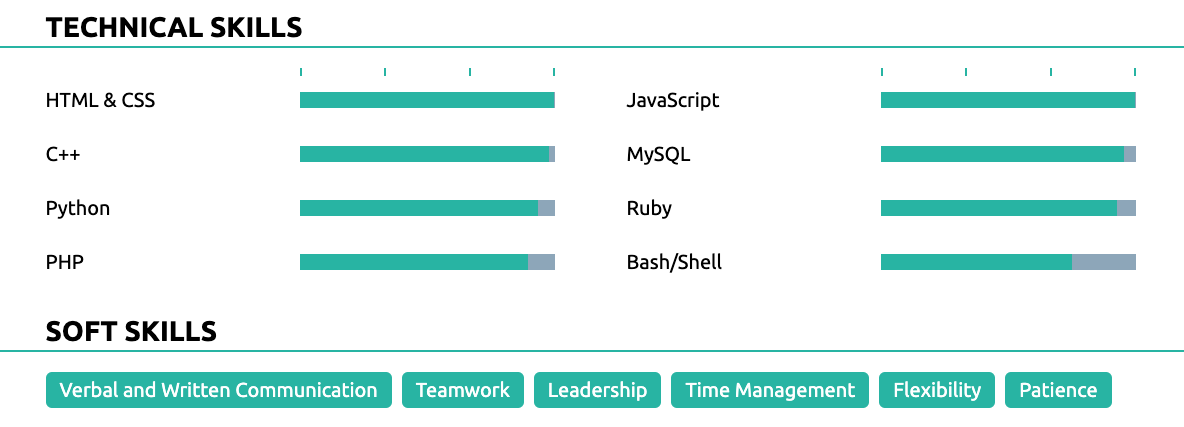
Step #9. Add These Optional Sections
So far, we have basically covered all resume must-haves.
The following optional sections won’t be a priority when you start to write your resume, however, they can turn out to be the cherry on top if you have them and if you have the space to list them.
Here are some of them:
Languages: The more, the merrier. If you speak two or more languages, don’t fail to put that in your resume. To list them, simply categorize your proficiency level into native, fluent, proficient, intermediate, or basic.
Hobbies & Interests: Although more personal than the rest of the sections, it doesn’t hurt to show a bit of your personality if you have the additional space in your resume. With a bit of luck, you and the recruiter may even share a hobby.
Volunteering Experience: Studies show that volunteering experience actually raises your chances of getting hired. In addition to showing that you are an individual motivated by more than just money, volunteering experience can be particularly great if you have recently graduated and have otherwise little work experience, or if you have an employment gap.
Certification & Awards: If you have awards that make you stand out in your field or certifications from experts and if they are relevant to your position, don’t hesitate to show them off! For example, if you’re an architect prized with the Global Award for Development Architecture - well, that’s definitely something you want to include in your resume.
Step #10. Start Applying!
And just like that, we can officially congratulate you for successfully starting - and finishing - your resume.
Chances are, if you got these tips right, you will land any job you go for. So go ahead and start applying!
Key Takeaways
That’s a wrap! Here’s the brief version of what we covered in this article:
- Before starting your resume, create an outline. It will provide you a skeleton to make the process of filling up each section much easier!
- A typical resume’s sections include a contact information section, a resume summary or objective, work and relevant experience, education, skills, and additional sections - if you have space.
- If possible, use the reverse-chronological order resume format. That is unless you’re a recent graduate or an entry-level professional - in that case, the functional or skill-based formats might be a better fit for you.
- Your past work experience should also start with your latest job, while the education section with the latest education entry. As a rule of thumb, start with your latest relevant experiences and go back as far as it’s relevant to the recruiter and the position you are applying for!

